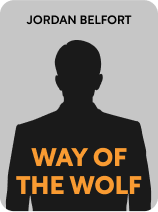

This article is an excerpt from the Shortform book guide to "Way of the Wolf" by Jordan Belfort. Shortform has the world's best summaries and analyses of books you should be reading.
Like this article? Sign up for a free trial here .
What are the top six sales methodologies? How do these methods compare to Jordan Belfort’s Straight Line system?
In his book Way of the Wolf, Jordan Belford teaches readers how to use the Straight Line selling method. However, this method is just one of many sales methodologies.
Here are the top six sales methodologies with sources for learning each.
The Top 6 Sales Methodologies
The Straight Line System is one of numerous sales methodologies. Here’s a brief overview of some of the top methodologies, ending with a commentary on how they compare with Straight Line.
Before outlining the methods, it’s necessary to define two terms. A sales methodology defines the techniques and skills (the how-tos) for moving a prospect through the sales process (the series of steps for closing a deal, such as prospecting, qualifying, presenting, objection handling, and so on).
Your sales methodology must fit your organization’s culture, as well as your product or service and target customer. The six most frequently cited sales methodologies are:
- SPIN
- Challenger
- Sandler
- SNAP
- Conceptual
- Solution
SPIN Selling
The SPIN Selling sales method uses questions to uncover a prospect’s needs and pain points. Introduced by Neil Rackham in the book SPIN Selling 30 years ago, it challenged the traditional hard-sell technique of jumping immediately into a sales pitch.
Key technique: Based on an analysis of over 35,000 sales calls, the method asks four types of questions with the acronym SPIN about the customer’s Situation, Problems, Implications (of not addressing the problems or pain points), and Need-Payoffs (how solving the problem would improve their situation).
Benefits: This method is best suited for smaller, transactional sales that don’t involve a large number of stakeholders. Its relationship emphasis may be useful for new companies that want to build trust in the market.
Read Shortform’s guide to SPIN Selling here.
The Challenger Sale
This approach counters the conventional wisdom that building a warm relationship is the key to successful selling; instead reps challenge the buyer to think differently. Described in the book The Challenger Sale, by Matthew Dixon and Brent Adamson, it’s based on research data from 90 companies worldwide and thousands of sales reps.
Key technique: The watchwords are teach, tailor, and take control. The sales rep takes control of sales by challenging customers’ thinking with new insights and pushing back instead of giving in to customer demands.
Benefits: This is an effective method for complex B2B sales because, due to the high stakes, customers are open to new insights and options.
Read Shortform’s guide to The Challenger Sale here.
Sandler
The Sandler Selling System positions the salesperson as a trusted advisor who is as invested as the customer in reaching a mutually beneficial conclusion. This low-pressure, relationship-focused method was developed in 1967 by David Sandler.
Key technique: The sales rep proactively raises and addresses typical objections such as budget. The method focuses more time on qualifying (via an in-depth needs assessment) than on closing, and lets go of the relationship when the seller’s solution isn’t an exact fit for the prospect’s problem. In a sense, the buyer convinces the seller he’s a good fit, rather than the reverse.
Benefits: This method can save time by eliminating poor prospects earlier rather than later. The method also generates collaborative long-term relationships where you can get repeat sales.
Read more about the Sandler Selling System here.
SNAP Selling
SNAP Selling, introduced by Jill Konrath in 2012, assumes that everyone is busy and flooded with too much information. Its goal is to make the sales process easy and fast by approaching it from the customer’s perspective.
Key technique: SNAP stands for: Keep it Simple, be iNvaluable, Align (with customer needs), and raise Priorities (make your solution a customer priority). Salespeople offer valuable knowledge, connect their product with what’s most important to the prospect, and make it easy for them to buy.
Benefits: This method reaches busy prospects at their level, and speeds up sales. It’s also an efficient way to sell if your company has strong name recognition (and you don’t need to spend time building trust with prospects) because you can jump right into quoting.
This method is presented in the 2012 book, SNAP Selling.
Conceptual Selling
Conceptual Selling (also called the Miller Helman sales methodology after its developers) is based on the idea that instead of buying a product or service, customers buy a concept or a desired outcome.
Key technique: Instead of leading with a pitch, the salesperson uncovers the buyer’s desired outcome through empathy, active listening, and asking questions in five categories: confirmation, new information, attitude, commitment, and issues. She then ties her product or solution to the customer’s end goal.
Benefits: This method is useful for complex sales where many people need to sign off. Stakeholders are more willing to back a solution to a problem than commit to buying a product. Once you get agreement on the broader solution, you can iron out details.
Learn about this method in the 1989 book, Conceptual Selling.
Solution Selling
Similar to Conceptual Selling, Solution Selling shifts the focus away from a product, but this time to the benefits of a customized solution. Developed in 1988 and continually updated, it has influenced other sales methodologies.
Key technique: Sales reps identify a prospect’s pain points and offer a customized solution involving a mix of various products and services to meet the prospect’s needs.
Benefits: This method is useful for creative services like graphic design and printing or interior design, where the salesperson can develop a custom package—for instance, a print provider could offer signage, business cards, and design services to fit the customer’s needs.
Learn about this method in the 1994 book, Solution Selling.
Straight Line System Comparison
The Straight Line System seems to be a hybrid of a sales methodology and a sales process—with the Straight Line (three certainties and two thresholds) being the process and targeted questions, tonality, body language, and scripts being the methodology.
Rather than following the trend of kinder, gentler customer-centric sales methodologies, Belfort’s Straight Line system is something of a throwback to traditional hard-selling (or at least extremely persistent) methods.
To some degree, all sales methods, including Belfort’s, aim to get into the prospect’s mind, and determine which buttons to push to close a deal. In a way, Belfort is just more straightforward about this shared goal and more overt about using psychological techniques to achieve it. However, in the Straight Line System, the seller’s interest continuously drives the sales conversation toward the end goal, despite Belfort’s mentions of mutual benefits.
Benefits: The system’s virtue is that, in contrast to other sales methodologies, it’s simple and straightforward. It likely shortens the sales cycle as claimed. However, it seems best suited to B2C sales, and it may not be effective for some other types of sales.
Shortform Resources
For general sales tips and advice, see the following Shortform guides:
- Sell or Be Sold, Grant Cardone
- Little Red Book of Selling, Jeffrey Gitomer
- The Psychology of Selling, Brian Tracy
- New Sales. Simplified., Mike Weinberg
- To Sell Is Human, Daniel Pink
For a study of what makes messages and campaigns persuasive:
- Made to Stick, Chip and Dan Heath
- Pitch Anything, Oren Klaff
- Influence, Robert B. Cialdini
To learn from success classics with sales applications:
- How to Win Friends and Influence People, Dale Carnegie
- Think and Grow Rich, Napoleon Hill
- The Power of Positive Thinking, Norman Vincent Peale

———End of Preview———
Like what you just read? Read the rest of the world's best book summary and analysis of Jordan Belfort's "Way of the Wolf" at Shortform .
Here's what you'll find in our full Way of the Wolf summary :
- How to sell like Jordan Belfort, the Wolf of Wall Street
- The 4 steps of the Straight Line selling method
- The 3 types of certainty you have to create to make a successful sale






